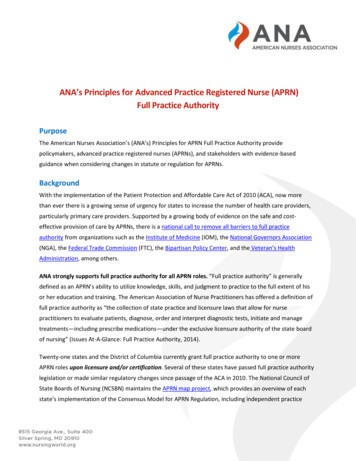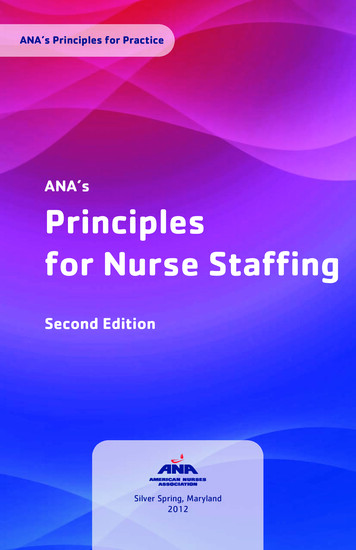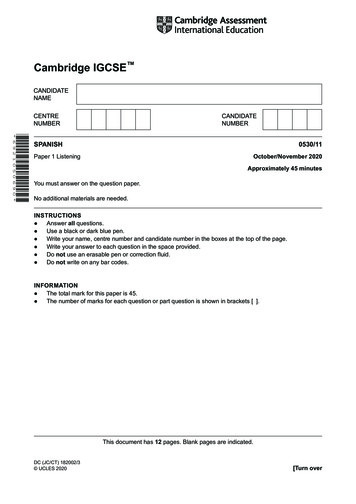
Transcription
ANA’s Principles for Advanced Practice Registered Nurse (APRN)Full Practice AuthorityPurposeThe American Nurses Association’s (ANA’s) Principles for APRN Full Practice Authority providepolicymakers, advanced practice registered nurses (APRNs), and stakeholders with evidence-basedguidance when considering changes in statute or regulation for APRNs.BackgroundWith the implementation of the Patient Protection and Affordable Care Act of 2010 (ACA), now morethan ever there is a growing sense of urgency for states to increase the number of health care providers,particularly primary care providers. Supported by a growing body of evidence on the safe and costeffective provision of care by APRNs, there is a national call to remove all barriers to full practiceauthority from organizations such as the Institute of Medicine (IOM), the National Governors Association(NGA), the Federal Trade Commission (FTC), the Bipartisan Policy Center, and the Veteran’s HealthAdministration, among others.ANA strongly supports full practice authority for all APRN roles. “Full practice authority” is generallydefined as an APRN’s ability to utilize knowledge, skills, and judgment to practice to the full extent of hisor her education and training. The American Association of Nurse Practitioners has offered a definition offull practice authority as “the collection of state practice and licensure laws that allow for nursepractitioners to evaluate patients, diagnose, order and interpret diagnostic tests, initiate and managetreatments—including prescribe medications—under the exclusive licensure authority of the state boardof nursing” (Issues At-A-Glance: Full Practice Authority, 2014).Twenty-one states and the District of Columbia currently grant full practice authority to one or moreAPRN roles upon licensure and/or certification. Several of these states have passed full practice authoritylegislation or made similar regulatory changes since passage of the ACA in 2010. The National Council ofState Boards of Nursing (NCSBN) maintains the APRN map project, which provides an overview of eachstate’s implementation of the Consensus Model for APRN Regulation, including independent practice
(defined as “no requirement for a written collaborative agreement, no supervision, no conditions forpractice”).While many are working to obtain full practice authority for APRNs through legislative and regulatoryefforts, analysis has revealed a disturbing trend in state legislation requiring a supervised post-licensurepractice or transition period, often referred to as “transition to practice” requirements, further delayingAPRN full practice authority. In several states (see table below), legislation has been enacted with theintention of moving closer to full practice authority for one or more APRN roles, yet the legislationincludes new requirements for a supervised practice period following licensure and/or certification.These legislative restrictions are modeled in concept after the state of Maine’s 1995/2007 legislation, asupervised practice provision of 24 months. Discussion with stakeholders reveals that these changes havenot been based on evidence but are the result of political compromise. As demonstrated in the table,states have unique time periods and standards for this “transition to practice,” none of which aresupported by the evidence or research.As states begin to implement these requirements, there is a growing realization of the potential impacton the workforce and access to care. In a report published in November 2014, the Nurse PhysicianAdvisory Taskforce for Colorado Healthcare (NPATCH) described how it evaluated perceived barrierscreated by the legislation passed in that state: employers are reticent to hire new graduates because theyare unable to prescribe independently, supervision requirements create an unnecessary burden forpreceptors and mentors, and APRNs are often unable to be empaneled and bill for servicesindependently. The Taskforce generally found the barriers to be real and made recommendations tostreamline the process for APRNs to obtain prescriptive authority, including reducing the transitionrequirement to six months’ full-time or 1,000 practice hours.
States with “Transition to Practice” 5/2007TransitionRequirement24 MonthsAPRN RoleAffectedCNP2020750 HoursAll APRNs20151,000 HoursCNP, CNS,CNM, CRNA20093,600 HoursCNP, CNS,CNM, CRNAVermontNevadaMinnesota201120132014Oversight Requirement/CommentsPhysician or CNPHours reduced - Once the provisionalprescriptive authority is granted, theadvanced practice REGISTERED nursemust obtain SEVEN HUNDRED FIFTYhours of documented experience in amutually structured prescribingmentorship either with a physician orwith an advanced practice REGISTEREDnurse who has full prescriptive authorityand experience in prescribingmedications.Hours reduced for prescribingmentorship with a physician or APRNrequired when seeking autonomousprescriptive authorityRequired when seeking independentprescriptive authority; physician orphysician and APRN24 Months andCNP, CNS,Collaborative Agreement with an APRN2,400 HoursCNM, CRNA2 Years orCNP, CNS,2,000 HoursCNMRequired when seeking independent CSII prescriptive authority; collaboratingphysician-approved protocols for CS IIprescribing2,080 HoursCNP, CNSCollaborative Agreement with an APRNor physicianor physicianCNP, CNS20143 Years and2,000-HoursMinimum3,600 HoursCNPCollaborative Agreement with aphysician; attestation of collaborationrequirement20152,000 HoursCNPTransition-to-Practice Agreement with asupervising provider (MD, DO, or NP)Connecticut2014New YorkNebraskaCollaborative Agreement with aphysician
quirement18 MonthsAPRN RoleAffectedCNPOversight Requirement/CommentsAn applicant who has never beencertified by Maryland or another stateshall consult and collaborate with aphysician or CNP mentor (who has atleast 3 years’ experience )Delaware20152 Years andCNP, CNS,4,000 Full-timeCNM, CRNAHoursCollaborative Agreement with a hospitalor integrated clinical setting(“Independent Practice”)MinimumWest Virginia20162 YearsCNP, CNS,CNM, CRNACollaborative Relationship andAgreement with a qualifiedcollaborating health care professional(physician or APRN) when seeking fullautonomous prescriptive authorityVirginiaMassachusetts20212021Reduced to 2years from 5yearsCNP1,000 hoursCNM2 yearsFile an attestation from thecollaborating physician with theBoard of NursingNPPsychiatricCNSCRNAsIndependently (withoutsupervision) - writeprescriptions, medicationorders, tests and therapeuticsafter fulfilling not less than 2years of supervised practice bya qualified practitioner (perBON regs) and given theBoard’s determination that theAPRN has demonstrated safeprescribing and good conduct.
National APRN organizations have provided information and guidance for their memberships on thisissue through position statements and briefs, which are referenced in this document. Continued andincreasing variability in state practice requirements for APRN full practice authority does not bring thenation toward consensus, but institutes additional layers of unnecessary regulatory constraint and costs.ANA and our constituent and state nurses associations (C/SNAs) are committed to working with othernational nursing organizations and key stakeholders to remove barriers to APRN practice in order toensure patients have access to safe and effective care from the providers of their choice.Essential Principles1. Consensus across four APRN rolesANA endorsed the Consensus Model for APRN Regulation and fully supports the definition of APRNsas licensed independent practitioners who are expected to practice within standards established orrecognized by a licensing body. ANA endorses the Nurse Practitioner Roundtable’s white paper,“Nurse Practitioner Perspective on Education and Post- Graduate Training,” and believes theprinciples espoused in that document apply to all APRN roles.a.Research conducted by the Council on Accreditation of Nurse Anesthesia Educational Programs(COA), (Cook, 2013) reports recent graduates of accredited certified registered nurse anesthetist(CRNA) programs are prepared and perform competencies for entry into practice uponcertification and licensure.b.In the Joint Statement of Practice Relations between Obstetrician-Gynecologists and CertifiedNurse-Midwives/Certified Midwives, the American College of Nurse-Midwives and the AmericanCollege of Obstetricians and Gynecologists affirm that graduates of accredited certified nursemidwife (CNM)/certified midwife (CM) educational programs who hold professional certificationare licensed independent providers.1c.In the document A Vision of the Future for Clinical Nurse Specialists, prepared by the NationalAssociation of Clinical Nurse Specialists (NACNS), NACNS espouses “An earned graduate degreein nursing from a nationally accredited program that prepares NSs represents attainment ofcore knowledge of advanced practice nursing and knowledge specific to CNS practice”(Goudreau, et al., p. 32).
2. Role competencea. APRNs are prepared at the graduate level and are deemed competent clinicians upongraduation and passage of national certification. There is no evidence to support the needfor additional post-licensure supervision of APRN practice beyond current educational andcertification standards.In several states, CNMs are not regulated as APRNs. For a detailed summary of the evolution of midwifery certification in theUnited States and recommendations for implementation of the APRN Consensus Model, see Midwifery in the United States and theConsensus Model for APRN Regulation.13. The FTC and the Bay Area Council Economic Institute (Weinberg & Kellerman, 2014) have noted thatunsubstantiated supervision increases health care costs and may exacerbate existing and projectedhealth care workforce shortages.4. Accountabilitya. Each APRN is personally accountable for his or her practice, and to patients, the respectivelicensing board, the nursing profession, and society. The notion that physicians shouldsupervise care provided by APRNs or that written collaborative agreements are needed isoutdated.b. It is within an APRN’s professional judgment and responsibility to assess andtreatpatients within the bounds of his or her legally authorized scope ofpractice.c. Individual accountability extends to legal liability. It is inappropriate to expect physicians, orany other providers, to accept responsibility or liability for care in which they have not beendirectly involved.5. Patient-centered, team-based, collaborative careAPRNs have been leaders in the development of innovative models of care delivery and are fullyprepared to serve as primary care providers in patient-centered primary care or medical homes.Costly and unnecessary legislative and regulatory requirements for physician supervision are at oddswith efforts to build interdisciplinary teams and create a more effective health care system.
6. Evidence-based policyDecades of research have established the safety and effectiveness of care by APRNs, and that body ofevidence has led institutions and organizations from the IOM to the NGA to AARP to call for the liftingof barriers to APRN practice. While further research on the safety and effectiveness of APRNs isunnecessary, ANA welcomes well-designed research studies to better understand the APRNworkforce, the impact of restrictions to APRN practice, and how best to increase access to effectivepatient-centered care.TerminologyFor a more detailed discussion of relevant terminology, see Words Matter: Guide to Discussing APRNPractice.APRN – The Consensus Model for APRN Regulation defines four APRN roles: certified nurse practitioner(CNP), certified registered nurse anesthetist (CRNA), certified nurse-midwife (CNM), and clinical nursespecialist (CNS).Full practice authority – Full practice authority is generally agreed to be defined as APRNs’ ability toutilize knowledge, skills, and judgment to practice to the full extent of their education andtraining.Consultation and collaboration – Consultation is the process whereby one provider whomaintainsprimary management responsibility for a patient’s care seeks the advice or opinion of another member ofthe health care team. Collaboration is the process whereby two providers jointly manage the care of apatient. Like physicians, APRNs consult and collaborate with many other health care providers, often on adaily basis, seeking advice that will improve patient care, developing collaborative management plans,and referring patients for specialized care. Physicians do so freely without any requirement orconsideration of a written agreement.Collaboration becomes a barrier to practice when laws or regulations spell out requirements for writtencollaborative agreements, which are typically a result of compromise in the legislative arena.The removal of barriers to APRN practice is critical to achieving ANA’s strategic goals, and work towardthat goal is highly valued by ANA members. ANA developed the Principles for APRN Full PracticeAuthority to provide guidance to C/SNAs as we work to “advocate for a health care system where RNsand APRNs can practice to the full extent of their knowledge and professional scope.” (ANA 2014–2016Strategic Goals)
SourcesAmerican Association of Nurse Practitioners. (2014). Issues At-A-Glance: Full Practice Authority. InCurrent Issues: Analysis and Briefs. Retrieved from /fullpracticeauthority.pdf.American College of Nurse Midwives. (2014). Issues Brief: Understanding Transition to Practice Languagein State Legislation. Retrieved erican College of Obstetricians and Gynecologists and American College of Nurse-Midwives. (2011).Joint Statement of Practice Relations between Obstetrician-Gynecologists and Certified NurseMidwives/Certified Midwives. In College Statement of Policy. Retrieved 20Statement%203.30.11.pdf.APRN Joint Dialogue Group. (2008). Consensus Model for APRN Regulation: Licensure, Accreditation,Certification & Education. Retrieved fromhttps://www.ncsbn.org/Consensus Model for APRN Regulation July 2008.pdf.Basu, S. (2014). Possible VA Change in Advanced Nursing Roles Sparks Heated Debate. U.S. Medicine, 1.Retrieved from ing-roles-sparks-heated-debate/.Colorado Department of Regulatory Agencies. (2014). Final Report and Recommendations on theRequirements for Advanced Practice Registered Nurses Seeking Prescriptive Authority. Retrievedfrom c/NPATCH final 11102014.pdf.Cook, K. A., Marienau, M., Wildgust, B., Gerbasi, F., & Watkins, J. (2013). Assessment of RecentGraduates’ Preparedness for Entry into Practice. AANA Journal, 81(5), 341-345. Retrieved viewer?sid 02&vid 3&hid 4106.Federal Trade Commission. (2014). Policy Perspectives: Competition and the Regulation of AdvancedPractice Nurses. Washington, DC: Authors. Retrieved dreau, K. A., Baldwin, K., Clark, A., Fulton, J., Lyon, B., Murray, T., et al. (2007). A Vision of the Futurefor Clinical Nurse Specialists. Harrisburg, PA: Authors. Retrieved fromhttp://www.nacns.org/docs/AVisionCNS.pdf.
Institute of Medicine. (2010). The Future of Nursing: Leading Change, Advancing Health. Retrieved fromhttp://www.nap.edu/openbook.php?record id 12956.National Council of State Boards of Nursing. (2014). Illustration of overview of each state’s consensusmodel implementation status. NCSBN’s APRN Campaign for Consensus: State Progress towardUniformity. Retrieved from https://www.ncsbn.org/5397.htm.National Governors Association Center for Best Practices. (2012). The Role of Nurse Practitioners inMeeting Increasing Demand for Primary Care. Washington, DC: Authors. Retrieved pdf/1212NursePractitionersPaper.pdf.Nurse Practitioner Roundtable. (2014). Nurse Practitioner Perspective on Education and Post-GraduateTraining. Washington, DC: Authors. Retrieved from /nproundtablestatementmay6th.pdf.Weinberg, M. & Kellerman, P. (2014). Full Practice Authority for Nurse Practitioners Increases Access andControls Cost. San Francisco, CA: Authors. Retrieved -practice/Approved by the ANA Board of Directors. Published June 2015.May 20, 2015, updated February 2020. 2016 American Nurses Association. All rights reserved. No part of this publication may be reproducedor utilized in any form or any means, electronic or mechanical, including photocopying and recording, orby any information storage and retrieval system, without permission.
ANA strongly supports full practice authority for all APRN roles. "Full practice authority" is generally defined as an APRN's ability to utilize knowledge, skills, and judgment to practice to the full extent of his or her education and training. The American Association of Nurse Practitioners has offered a definition of










